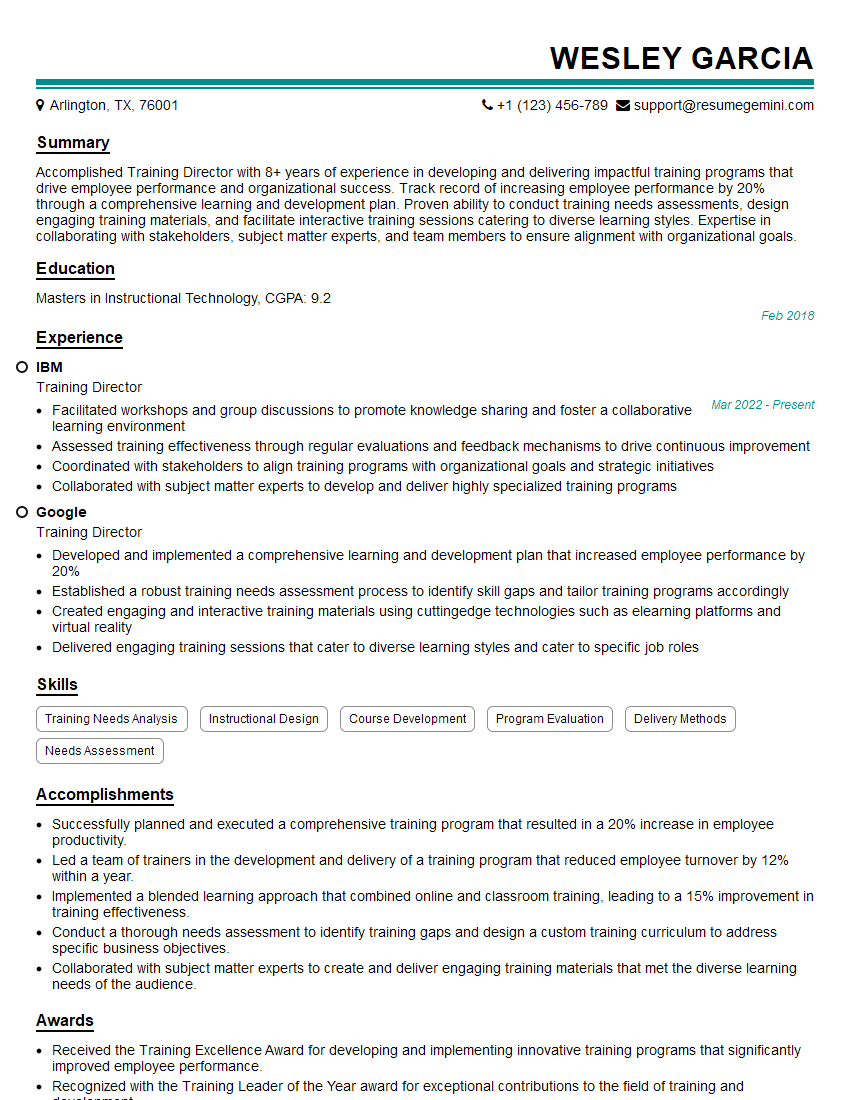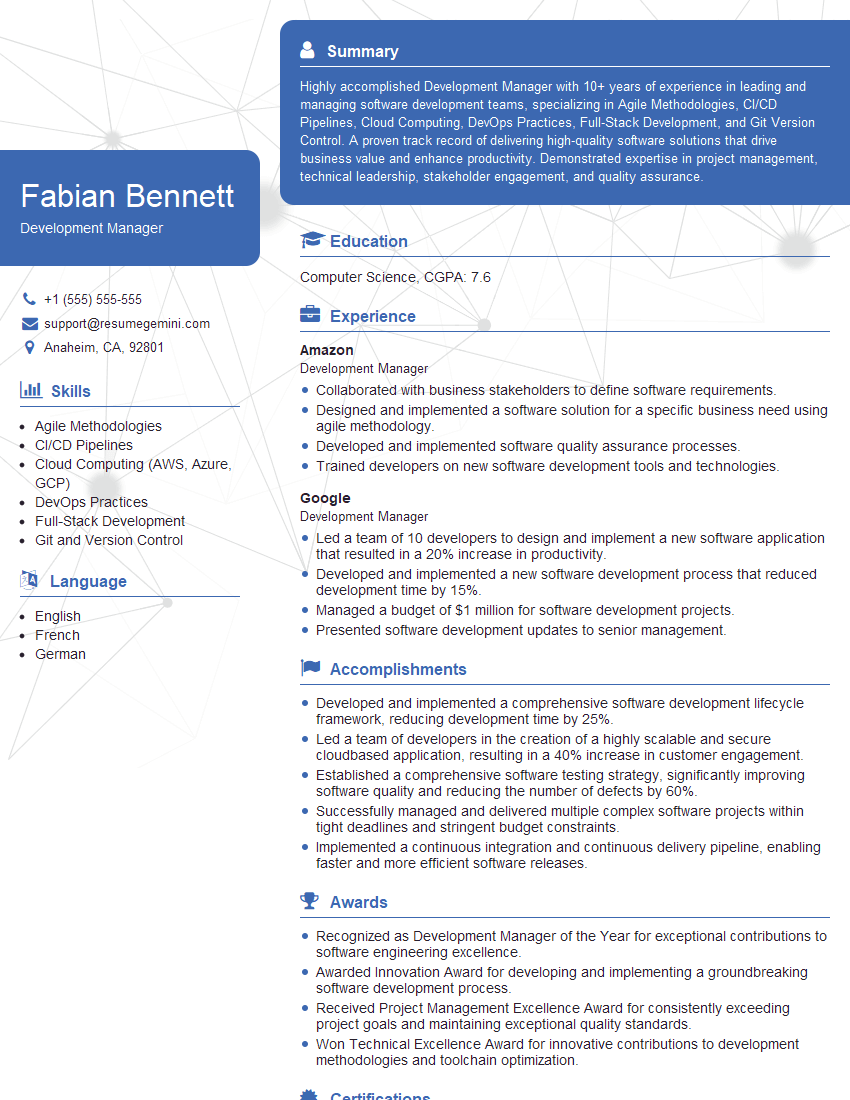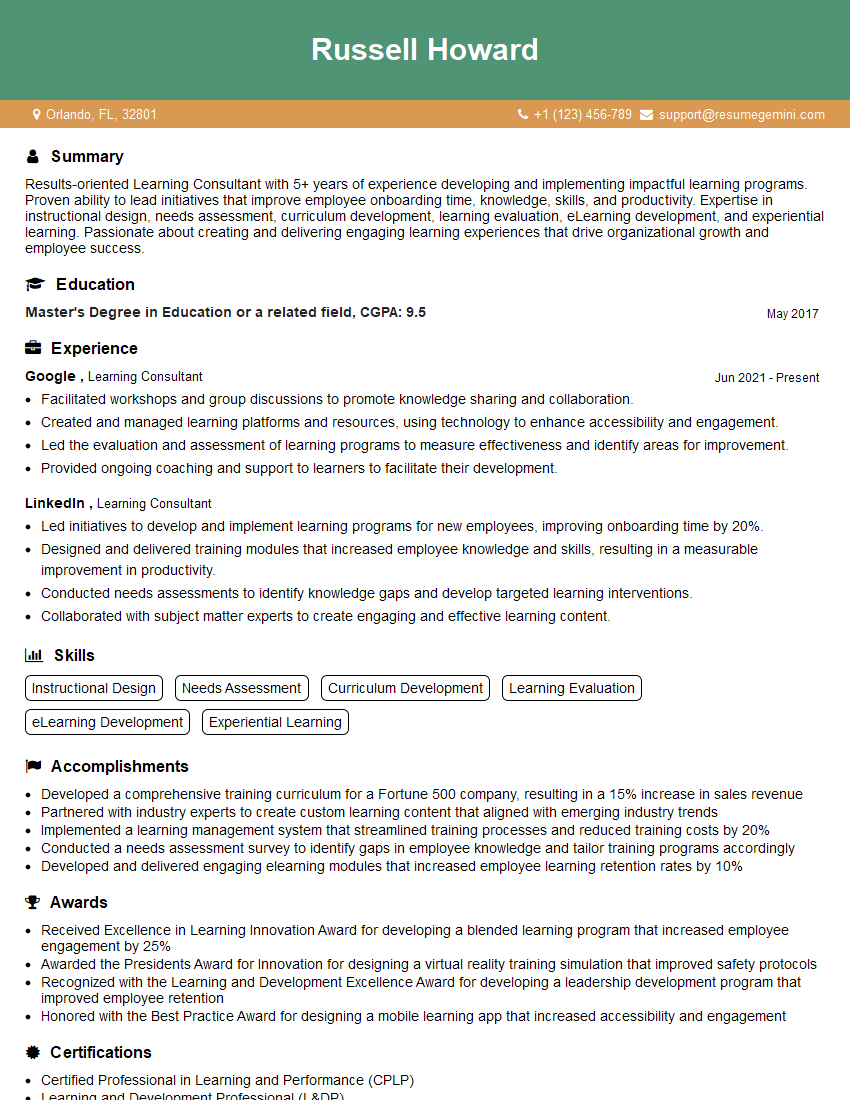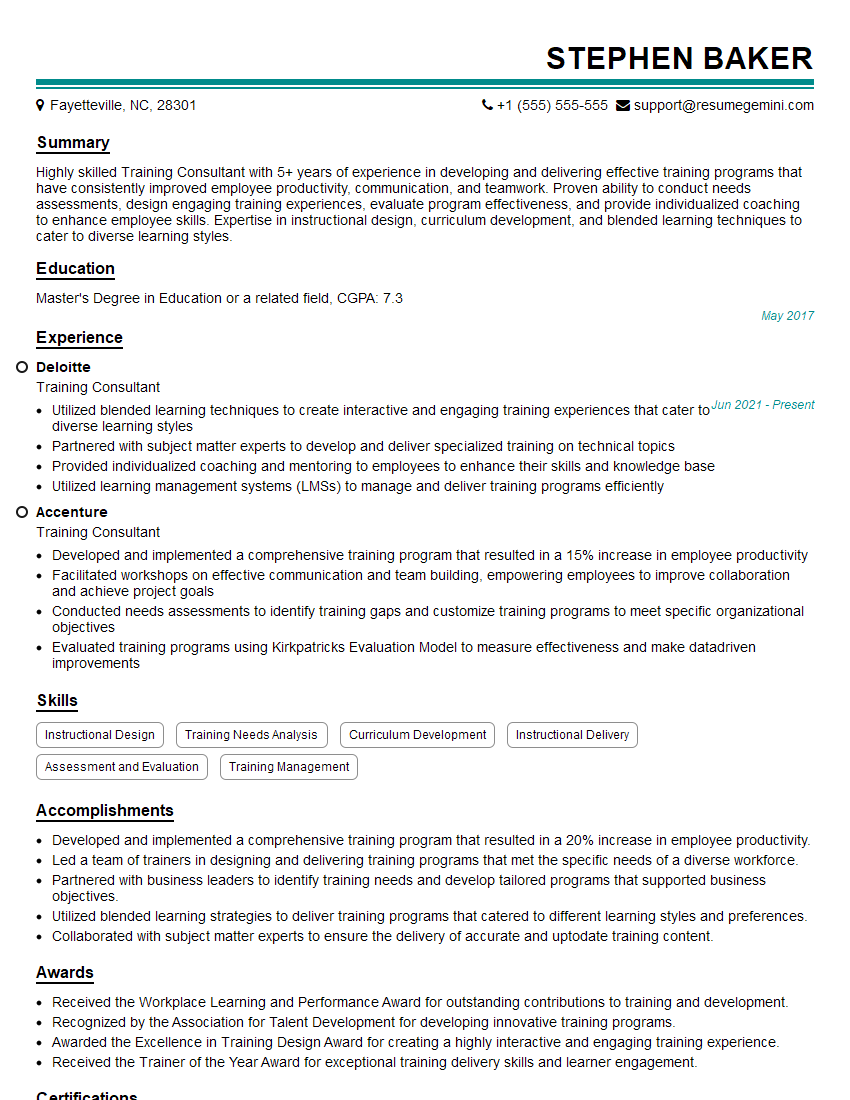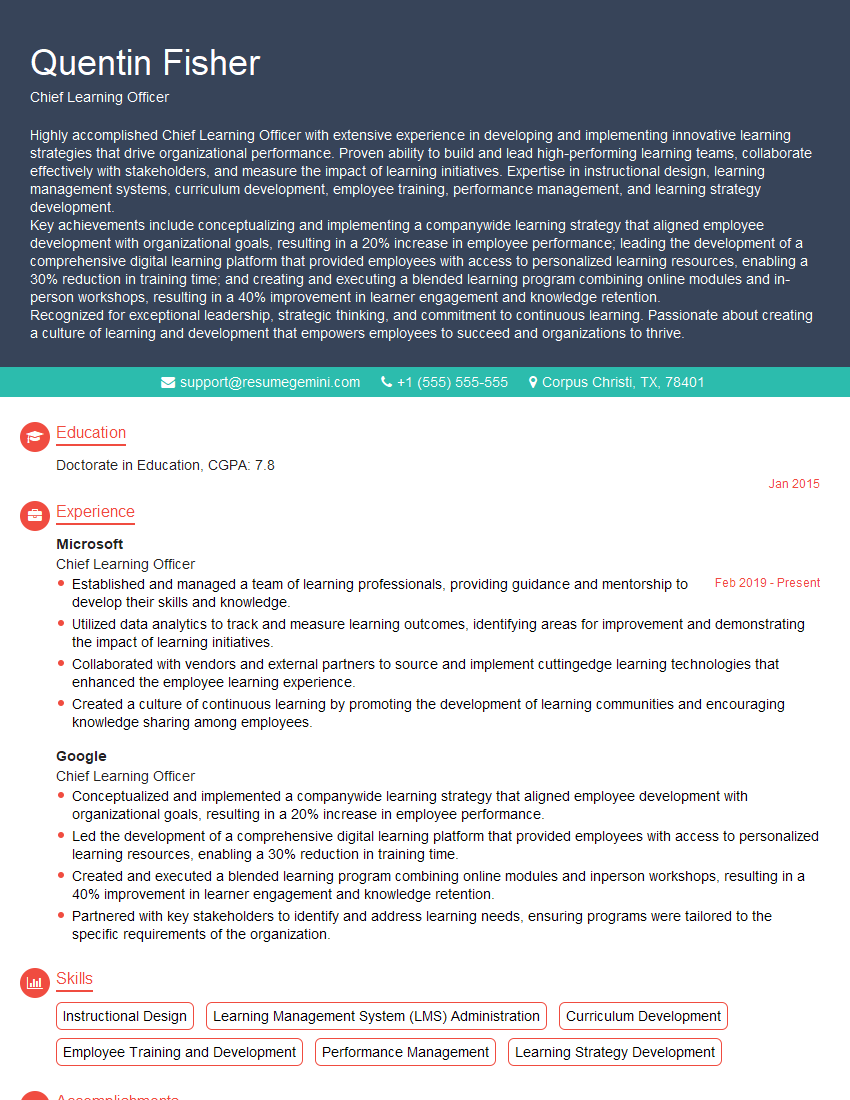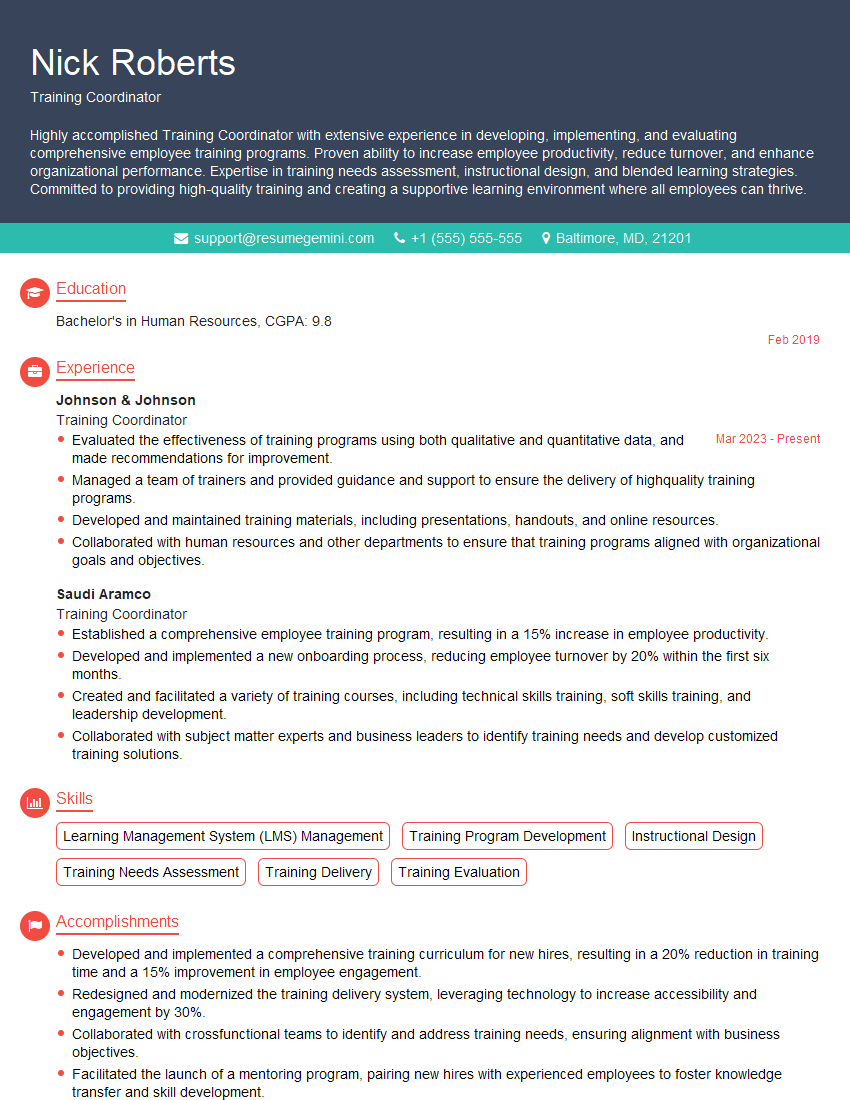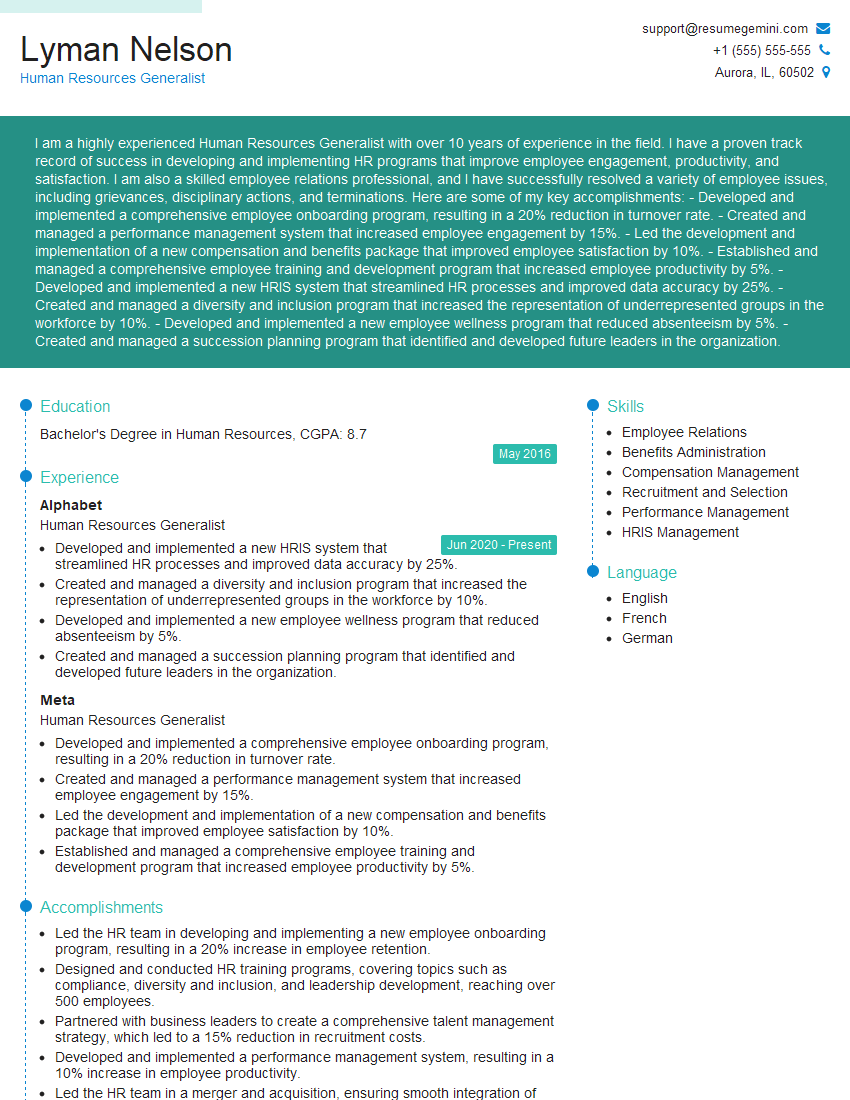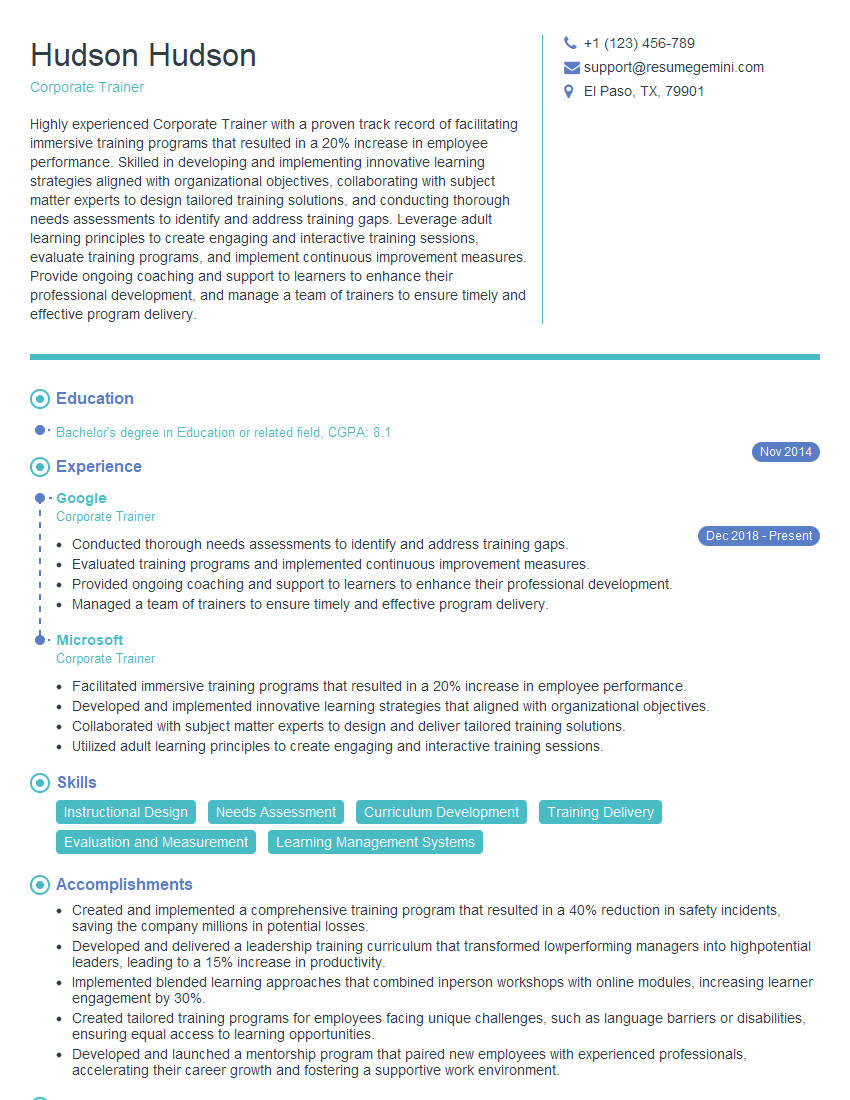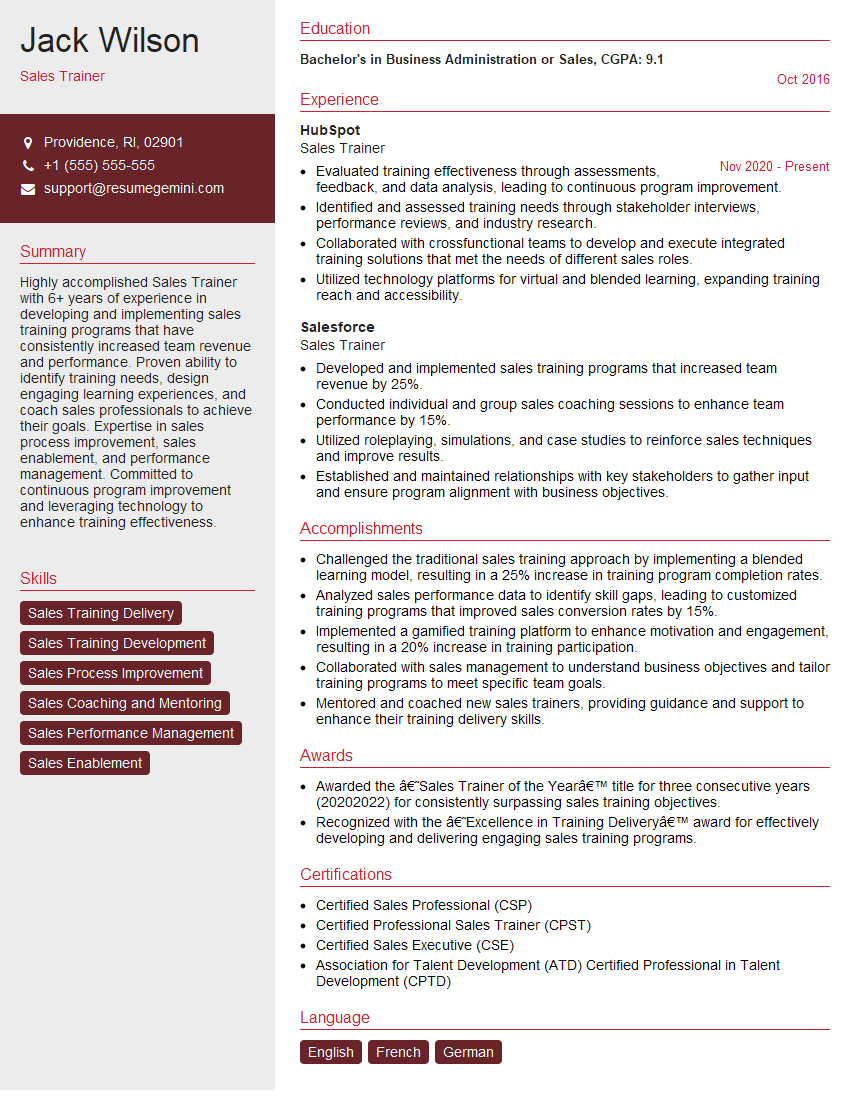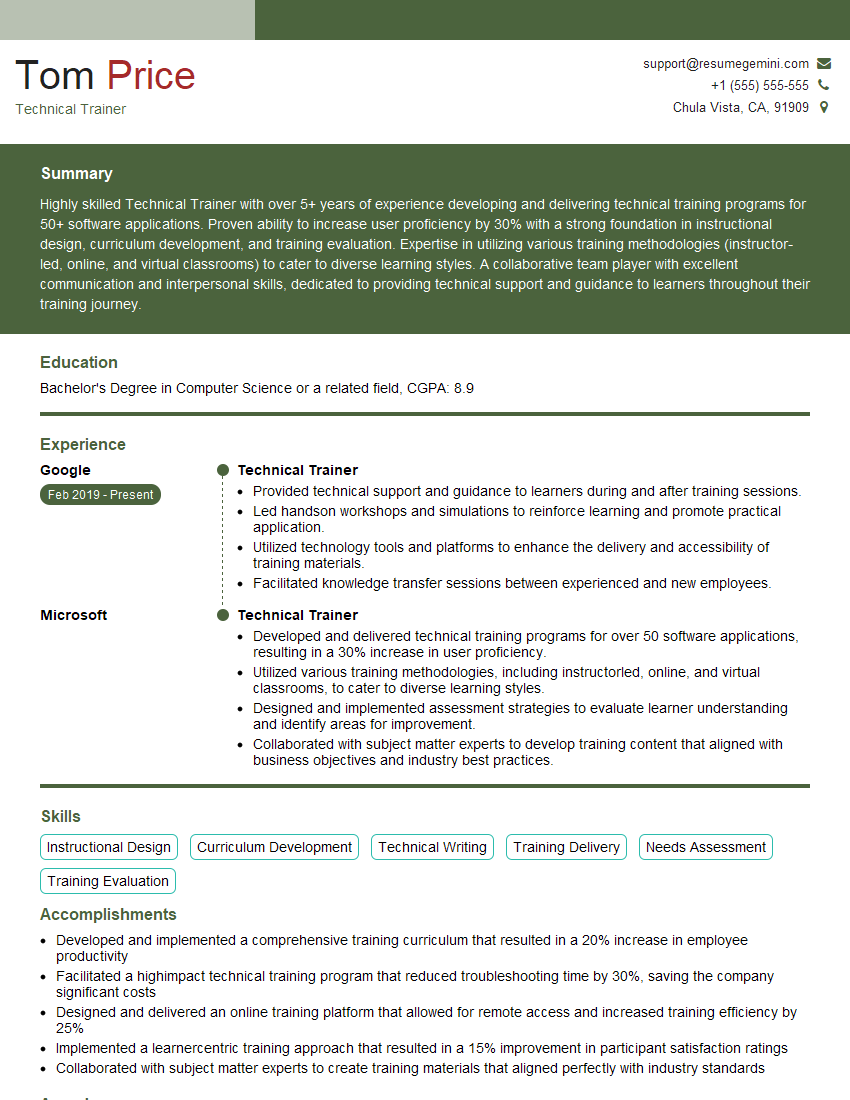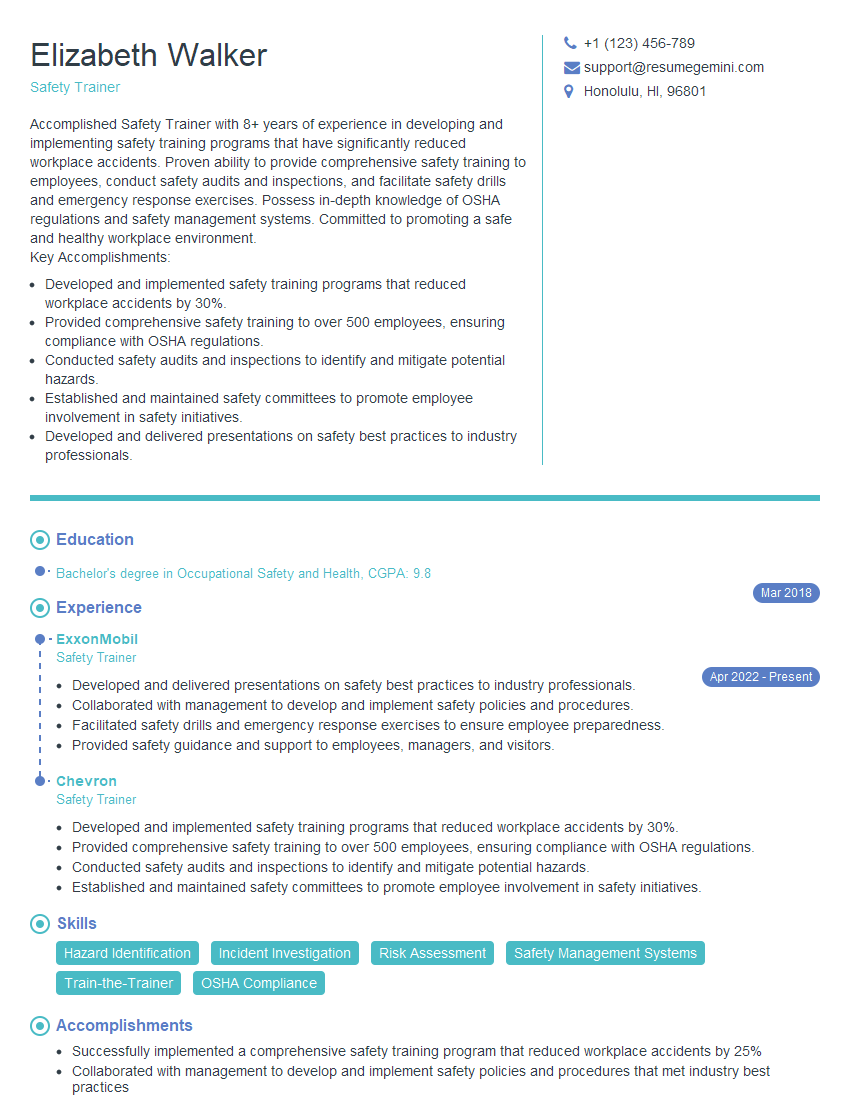Interviews are more than just a Q&A session—they’re a chance to prove your worth. This blog dives into essential On-the-Job Training (OJT) interview questions and expert tips to help you align your answers with what hiring managers are looking for. Start preparing to shine!
Questions Asked in On-the-Job Training (OJT) Interview
Q 1. Describe your experience designing and delivering OJT programs.
Designing and delivering effective On-the-Job Training (OJT) programs requires a systematic approach. It starts with a thorough needs analysis to identify skill gaps. Then, I develop a structured training plan, outlining learning objectives, methods, timelines, and assessment strategies. This plan considers the learner’s experience level, learning style, and the specific job requirements. I then create engaging training materials, leveraging a variety of methods like job shadowing, mentoring, coaching, and hands-on practice. Finally, I deliver the training, providing ongoing feedback and support, and regularly evaluating the program’s effectiveness.
For example, in my previous role at a software company, I designed an OJT program for new software developers. The program involved a phased approach: shadowing senior developers for the first week, working on small projects with increasing complexity over the next month, and finally, participating in a real-world project under supervision. This structured approach ensured a smooth transition for new hires and fostered a supportive learning environment. We also utilized a buddy system, pairing each new developer with an experienced colleague who could provide additional support and mentorship.
Q 2. How do you assess the effectiveness of your OJT programs?
Assessing the effectiveness of OJT programs is crucial to ensure they meet their intended goals. I employ a multi-faceted approach that combines quantitative and qualitative methods. Quantitative methods include pre- and post-training assessments, measuring improvement in skills and knowledge. For instance, I might use a knowledge test before and after the training to quantify knowledge gain. Qualitative methods involve collecting feedback from trainees through surveys, interviews, or focus groups to gauge their satisfaction and perception of the training’s value. I also track on-the-job performance metrics, such as productivity, error rates, and customer satisfaction, to gauge the impact of the training on real-world outcomes. Regular monitoring and analysis of these data points allow me to identify areas for improvement and make adjustments to the program as needed. This iterative approach ensures that the OJT remains relevant and impactful.
Q 3. What methods do you use to identify training needs within an organization?
Identifying training needs requires a combination of approaches. I start with analyzing job descriptions and performance reviews to pinpoint skill gaps and areas needing improvement. I also conduct interviews with employees and managers to gather their perspectives on training requirements and identify unmet needs. Observation of employees performing their tasks provides valuable insights into their workflow and identifies areas where training could improve efficiency and effectiveness. Analyzing performance data, such as error rates or productivity metrics, can reveal areas where training is needed. Finally, I consider the organization’s overall strategic goals to ensure that the training aligns with the company’s objectives. A holistic approach ensures that the identified training needs are comprehensive and relevant.
For example, in a recent project, a high number of customer complaints pointed to a lack of effective communication skills among our customer service representatives. Through interviews and performance reviews, we confirmed this deficiency, leading to the development of targeted training in communication and conflict resolution.
Q 4. Explain your approach to creating engaging and effective training materials.
Creating engaging and effective training materials is paramount for successful OJT. I focus on using a variety of methods to cater to different learning styles. This might involve creating interactive exercises, using real-world case studies, incorporating simulations or role-playing, and utilizing visual aids like videos or presentations. I strive to make the content relevant, concise, and easily digestible. The materials should be well-organized, visually appealing, and accessible to all trainees. I often incorporate feedback loops throughout the training, allowing trainees to actively participate and receive immediate feedback. This interactive approach keeps learners engaged and facilitates better knowledge retention.
For example, when creating materials for a technical training program, I used interactive simulations to allow trainees to practice troubleshooting equipment malfunctions in a safe environment before handling real equipment. This hands-on approach made learning more engaging and effective.
Q 5. How do you handle challenging trainees or those who struggle to grasp concepts?
Handling challenging trainees or those who struggle to grasp concepts requires patience, understanding, and a flexible approach. I start by identifying the root cause of the difficulty. Is it a lack of prior knowledge, a specific learning disability, or simply a lack of motivation? Once the cause is identified, I tailor my approach accordingly. This might involve providing additional individual support, breaking down complex concepts into smaller, more manageable chunks, using different teaching methods to cater to various learning styles, or offering additional resources such as online tutorials or mentoring opportunities. Open communication and a supportive learning environment are crucial. I emphasize positive reinforcement and celebrate even small successes to build confidence and encourage progress. Regular check-ins and individualized feedback are also vital components of this approach.
Q 6. What are some common challenges you’ve faced in implementing OJT programs?
Implementing OJT programs often presents challenges. One common issue is securing the time commitment from both trainers and trainees, especially in busy work environments. Another is ensuring consistent training quality across different trainers. Maintaining updated training materials in the face of evolving technology or procedures is also a recurring challenge. Sometimes, there can be resistance from employees who are hesitant to adopt new methods or technologies. Effective communication, clear expectations, and a well-structured program are crucial to overcome these challenges. Providing adequate resources and support for both trainers and trainees is also essential for successful implementation.
Q 7. How do you ensure OJT aligns with overall organizational goals and objectives?
Aligning OJT with overall organizational goals is crucial for its effectiveness. I start by reviewing the organization’s strategic plan and identifying key performance indicators (KPIs) to understand the overall objectives. Then, I develop OJT programs that directly address the skills and knowledge needed to achieve those objectives. The training content and assessment methods should directly reflect the organization’s priorities. Regular review and evaluation of the OJT program against the organization’s strategic goals ensure continued relevance and impact. It’s a continuous cycle of evaluation and refinement to ensure OJT remains a valuable investment for the company.
Q 8. Describe your experience with different OJT delivery methods (e.g., mentoring, shadowing, job rotation).
My experience encompasses a wide range of OJT delivery methods, each tailored to specific learning objectives and trainee needs. Mentoring involves pairing a trainee with an experienced employee who provides guidance, support, and feedback over an extended period. I’ve successfully implemented mentoring programs where junior software developers were paired with senior architects, resulting in significant skill improvement and faster project integration. Shadowing, where trainees observe an expert performing tasks, is ideal for skills requiring precise observation. For example, I used shadowing to train new medical technicians on sterile procedures, ensuring they grasped the nuances of the process before independent practice. Finally, job rotation allows trainees to experience different aspects of a role or department. This approach proved beneficial when training administrative assistants, exposing them to various functions like scheduling, correspondence, and data entry, leading to a more well-rounded skillset.
Q 9. How do you measure the return on investment (ROI) of OJT programs?
Measuring the ROI of OJT programs requires a multi-faceted approach. We can’t just look at the immediate cost of training; we need to consider the long-term benefits. Key metrics include improved employee performance (measured through productivity increases, error reduction, or improved quality of work), reduced employee turnover (as better-trained employees are more satisfied and engaged), increased efficiency (leading to cost savings), and ultimately, a boost in profitability. For instance, in a recent project, we tracked the number of customer service calls resolved per hour by trainees before and after OJT. The significant improvement in efficiency translated directly into reduced operational costs, providing a clear ROI calculation. Qualitative data, such as employee feedback surveys, also plays a crucial role in assessing the program’s effectiveness and areas for improvement.
Q 10. What technology or tools have you used to support OJT delivery?
Technology plays a crucial role in modern OJT delivery. I’ve extensively used Learning Management Systems (LMS) like Moodle and Canvas to deliver online training modules, track progress, and assess learning outcomes. These systems allow for flexible learning, with trainees accessing materials at their own pace. We also leverage video conferencing tools like Zoom and Microsoft Teams for virtual shadowing and mentoring sessions, enabling remote training and collaboration. Furthermore, microlearning platforms offering short, focused learning modules have proven effective for reinforcing key concepts and skills learned during hands-on training. For example, using short videos to demonstrate specific equipment operation within a manufacturing setting significantly improved trainee competency and safety.
Q 11. How do you adapt your training style to different learning styles?
Adapting to different learning styles is paramount for effective OJT. I use a multi-modal approach, combining various delivery methods to cater to visual, auditory, and kinesthetic learners. For visual learners, I incorporate diagrams, charts, and videos; for auditory learners, I emphasize explanations and discussions; and for kinesthetic learners, I prioritize hands-on activities and simulations. For example, while training technicians on equipment repair, I provided detailed diagrams for visual learners, verbal instructions for auditory learners, and opportunities for hands-on practice for kinesthetic learners. Regular feedback and observation allow me to identify individual preferences and adjust my approach accordingly.
Q 12. Describe a time you had to revise an OJT program due to unexpected challenges.
During a sales training program, we initially focused heavily on theoretical knowledge and role-playing. However, we soon realized that trainees struggled to apply this knowledge in real-world customer interactions. We observed a significant drop in trainee confidence and performance during the practical application phase. To address this, we revised the program by incorporating more real-world case studies, incorporating simulated customer interactions with immediate feedback, and adding mentorship sessions with experienced sales representatives. This revised approach focused more on practical skills and provided targeted support, leading to a significant improvement in trainee performance and a higher completion rate.
Q 13. How do you ensure the safety of trainees during hands-on OJT?
Safety is the utmost priority during hands-on OJT. Before starting any hands-on activity, I conduct thorough safety briefings, covering potential hazards and appropriate safety protocols. Trainees are required to wear appropriate Personal Protective Equipment (PPE) and are closely supervised by experienced staff. We use checklists to ensure all safety procedures are followed, and regular safety checks are conducted throughout the training. For example, during equipment operation training, we utilize safety harnesses and lockout/tagout procedures to prevent accidents. Regular safety drills and refresher training reinforce safety awareness and build a strong safety culture. I also emphasize the importance of reporting any near misses or safety concerns.
Q 14. What strategies do you use to maintain trainee engagement during OJT?
Maintaining trainee engagement is crucial for successful OJT. I achieve this through several strategies: Firstly, I make the training relevant and relatable to the trainee’s job role and responsibilities, connecting learning directly to their daily tasks. Secondly, I incorporate various interactive elements such as group discussions, quizzes, and games to break up the monotony and encourage active participation. Regular feedback and recognition also help build confidence and motivation. Finally, I foster a supportive learning environment where trainees feel comfortable asking questions and seeking clarification. For example, I used a gamified approach for a product training program, awarding points for completing modules and achieving high scores on quizzes, which significantly boosted trainee engagement and completion rates.
Q 15. How do you provide feedback and support to trainees during the OJT process?
Providing feedback and support during OJT is crucial for trainee success. My approach is multifaceted and focuses on both timely, constructive criticism and ongoing encouragement. I believe in a blend of formal and informal feedback methods.
Formal Feedback: This includes regular scheduled meetings – perhaps weekly or bi-weekly, depending on the complexity of the training – where we review progress against pre-defined learning objectives. I use a structured approach, focusing on both strengths and areas for improvement, always offering specific examples rather than generalizations. For instance, instead of saying ‘Your communication skills need improvement,’ I’d say, ‘During the client presentation yesterday, I noticed your tone could have been more confident. Let’s practice projecting your voice more effectively.’ I also utilize rating scales or checklists to objectively assess performance against specific criteria.
Informal Feedback: This is equally important. I provide ongoing support through observation and coaching during daily tasks. I’ll offer suggestions in real-time, answering questions immediately, and providing guidance as they encounter challenges. For example, if a trainee is struggling with a particular software application, I’ll walk them through the process step-by-step, offering practical tips and answering any questions they may have.
Mentorship: Beyond feedback, I foster a supportive environment through mentorship. This involves sharing my own experiences, offering guidance on career development, and actively listening to their concerns and challenges. I encourage questions and open communication to build trust and a collaborative learning environment.
Career Expert Tips:
- Ace those interviews! Prepare effectively by reviewing the Top 50 Most Common Interview Questions on ResumeGemini.
- Navigate your job search with confidence! Explore a wide range of Career Tips on ResumeGemini. Learn about common challenges and recommendations to overcome them.
- Craft the perfect resume! Master the Art of Resume Writing with ResumeGemini’s guide. Showcase your unique qualifications and achievements effectively.
- Don’t miss out on holiday savings! Build your dream resume with ResumeGemini’s ATS optimized templates.
Q 16. How do you track trainee progress and document their accomplishments?
Tracking trainee progress and documenting accomplishments is vital for evaluating the OJT program’s effectiveness and ensuring accountability. My system combines both quantitative and qualitative data collection methods.
Quantitative Data: I use checklists, scorecards, or even simple spreadsheets to track the completion of tasks and training modules. This allows for easy monitoring of progress against defined learning objectives. For example, if the training includes specific software proficiency, I’d track their completion of each module and their scores on associated quizzes or practical assessments.
Qualitative Data: This captures the ‘softer’ aspects of learning. I utilize observation notes, documented feedback sessions, and trainee self-assessments. This provides richer, more nuanced insights into their understanding and application of learned skills. I might note observations such as their problem-solving approach, their teamwork skills, or their ability to adapt to new challenges. I keep detailed notes after each training session, including both formal and informal feedback exchanges.
Documentation: All progress, feedback, and assessments are meticulously documented in a centralized system, which might be a shared company drive, an LMS, or a dedicated training database. This ensures transparency, consistency, and facilitates performance reviews. A well-maintained record is crucial if there are any performance issues or disputes later.
Q 17. What are the key elements of a successful OJT program?
A successful OJT program hinges on several key elements, which I meticulously incorporate into my designs and implementations.
Clearly Defined Objectives: The training must have specific, measurable, achievable, relevant, and time-bound (SMART) objectives. Without clearly stated goals, it’s impossible to assess the program’s success or track trainee progress effectively.
Structured Training Plan: A well-structured plan details the training content, methodology, timeline, and assessment methods. This provides a roadmap for both the trainer and the trainee, ensuring consistency and preventing unnecessary detours.
Experienced and Skilled Trainers: The trainer needs to possess in-depth knowledge and practical experience in the area being taught. They should also have strong communication, mentorship, and feedback skills.
Regular Feedback and Support: As mentioned previously, ongoing feedback, mentoring and support is essential for trainee success. This shouldn’t be a one-off event but a continuous process.
Proper Resources and Environment: Trainees need access to necessary resources such as equipment, software, and documentation. The training environment should be supportive, encouraging collaboration and knowledge sharing.
Evaluation and Improvement: The program’s effectiveness should be regularly reviewed, and changes implemented based on feedback and performance data. This iterative approach ensures the program’s continuous improvement.
Q 18. How do you ensure compliance with relevant regulations and policies in your OJT programs?
Compliance is paramount in any OJT program. My approach ensures adherence to all relevant regulations and policies through several key strategies.
Thorough Knowledge of Regulations: I begin by meticulously researching and understanding all applicable laws, industry standards, and company policies related to safety, ethics, and workplace conduct. This might include OSHA regulations, industry-specific certifications, or internal compliance guidelines.
Integration of Compliance into Training: Compliance isn’t an afterthought; it’s woven into the core fabric of the OJT program. Training materials explicitly address relevant regulations, safety procedures, and ethical considerations. For example, if the training involves operating machinery, the program will include detailed instruction on safety procedures and the use of personal protective equipment (PPE).
Documentation and Record Keeping: All compliance-related training activities are meticulously documented. This includes training records, safety certifications, and any incident reports. This documentation serves as proof of compliance and aids in internal audits.
Regular Audits and Reviews: I regularly conduct self-audits and participate in internal audits to assess our compliance status and identify any potential gaps. This proactive approach ensures timely identification and correction of any non-compliance issues.
Q 19. How do you evaluate the effectiveness of different training methods?
Evaluating training method effectiveness is crucial for maximizing ROI and continuous improvement. I utilize a mixed-methods approach, combining quantitative and qualitative data analysis.
Quantitative Metrics: I use metrics like pre- and post-training assessments to measure knowledge gain, task completion times, and error rates. These provide objective measures of effectiveness.
Qualitative Feedback: I collect feedback through surveys, interviews, and focus groups to gauge trainee satisfaction, identify areas needing improvement, and understand their learning experiences. This provides valuable contextual information that quantitative data alone can’t capture.
Return on Investment (ROI): I calculate ROI by considering the costs of the training program (trainer time, materials, etc.) and comparing it to the benefits (improved productivity, reduced errors, increased employee retention). This helps justify the training investment.
Longitudinal Tracking: I track performance beyond the immediate post-training period to assess the lasting impact of the training. This helps identify whether the training resulted in sustainable improvement.
Q 20. What are your preferred methods for assessing trainee knowledge and skills after OJT?
Assessing trainee knowledge and skills after OJT requires a holistic approach that combines various assessment methods.
Practical Assessments: Hands-on tasks and simulations allow trainees to demonstrate their skills in a real-world context. This could involve shadowing experienced professionals, working on live projects, or completing scenario-based exercises.
Written Exams or Quizzes: These are useful for assessing theoretical knowledge and understanding of concepts. They help identify knowledge gaps that may need further attention.
Performance Reviews: Regular performance reviews provide ongoing feedback and help assess how well trainees are applying their skills in their daily work. This includes assessing their overall contribution, identifying areas of strength and improvement, and setting clear goals for future development.
360-Degree Feedback: This approach gathers feedback from multiple sources, including peers, supervisors, and even clients. This offers a well-rounded perspective on the trainee’s performance, identifying areas where they excel and areas where they could benefit from additional support.
Q 21. Describe your experience with developing OJT evaluation metrics.
Developing OJT evaluation metrics requires a deep understanding of the training objectives and the desired outcomes. My approach focuses on creating metrics that are both relevant and measurable.
Alignment with Objectives: I start by clearly defining the training objectives. The metrics must directly measure the extent to which these objectives are achieved. For example, if an objective is to improve customer service skills, metrics might include customer satisfaction scores, the number of resolved customer issues, or the rate of repeat customer calls.
Balanced Scorecard: I often employ a balanced scorecard approach, including metrics that assess various aspects of performance. This might include metrics related to knowledge acquisition, skill proficiency, productivity, and employee satisfaction.
Data Collection Methods: I identify appropriate data collection methods, which might include pre- and post-training assessments, performance evaluations, observation checklists, and trainee self-reports.
Data Analysis and Reporting: I establish a system for collecting, analyzing, and reporting the data. This allows for regular monitoring of program effectiveness and identification of areas for improvement. The use of charts and graphs helps make the data more understandable and actionable.
Iteration and Improvement: The metrics themselves should be regularly reviewed and updated based on feedback, changing business needs, and the overall effectiveness of the program. This ensures that they remain relevant and accurately reflect the program’s impact.
Q 22. How do you facilitate knowledge transfer and collaboration among trainees?
Facilitating knowledge transfer and collaboration during OJT is crucial for effective training. I achieve this through a multi-pronged approach focusing on both structured learning and informal interactions.
Mentorship Programs: I pair trainees with experienced employees who act as mentors, guiding them through challenges and sharing their expertise. This fosters a supportive environment for knowledge sharing and building strong professional relationships. For example, a junior software developer might be paired with a senior developer to learn best practices and problem-solving techniques.
Group Projects and Activities: Collaborative projects allow trainees to learn from each other and develop teamwork skills. These could involve working on real-world tasks, solving simulated problems, or participating in case studies. The collective brainstorming and problem-solving process accelerates knowledge absorption and reinforces learning.
Knowledge-Sharing Platforms: I leverage internal wikis, forums, or shared document repositories to create a central hub for information. This allows trainees to access information, share their own insights, and ask questions at their convenience. This platform promotes a culture of continuous learning and collaboration.
Regular Feedback and Check-ins: Frequent check-ins with both trainees and mentors allow me to monitor progress, identify challenges, and address knowledge gaps promptly. Regular feedback sessions ensure the trainees are actively engaging with the material and provide valuable insights into their learning journey.
Q 23. How do you integrate OJT with other learning and development initiatives?
Integrating OJT with other learning and development initiatives is key to creating a holistic learning experience. I ensure alignment through several strategies:
Pre-OJT Training: Before starting OJT, trainees receive foundational training through online modules, workshops, or classroom sessions. This provides the necessary background knowledge and skills to hit the ground running during their on-the-job experience. For instance, a new sales representative might receive product training before interacting with clients.
OJT as a Component of a Larger Program: OJT is not an isolated event; it’s integrated into a broader learning curriculum. This might include formal certifications, leadership development programs, or specialized training courses. A combination of classroom learning and OJT might be used for a specialized technical skill.
Post-OJT Reinforcement: Following OJT, further training, such as advanced courses, coaching sessions, or mentorship continues to support ongoing development and skill enhancement. This approach ensures continuous growth and keeps skills sharp.
Consistent Evaluation: A unified evaluation system across all learning initiatives allows for tracking of progress and identification of areas requiring further attention. A consistent approach ensures continuity of assessment and makes it easier to pinpoint training gaps.
Q 24. How do you ensure ongoing support and development for trainees after OJT completion?
Ongoing support after OJT completion is vital for retaining newly acquired skills and ensuring the success of the training program. I ensure this through:
Mentorship Continuation: Mentorship relationships often continue beyond the formal OJT period, providing a consistent source of guidance and support. This sustained mentorship helps address challenges and fosters continuous growth.
Follow-up Check-ins: Regular check-ins allow for performance monitoring, addressing potential issues, and offering further support. This could involve meetings, email communication, or performance reviews.
Access to Resources: Trainees maintain access to relevant resources, such as online learning platforms, reference materials, or internal experts, even after the OJT is complete. This provides continuous access to valuable information.
Feedback Mechanisms: Established feedback loops allow trainees to provide input on their ongoing development needs, ensuring future training opportunities are aligned with their career aspirations. This approach demonstrates ongoing support and development beyond the initial training period.
Q 25. What are your strategies for onboarding new trainees into OJT programs?
Onboarding new trainees effectively sets the stage for a successful OJT experience. My strategy involves:
Clear Expectations and Goals: I provide trainees with a clear understanding of the OJT program’s objectives, timeline, and expectations. This includes outlining roles, responsibilities, and performance metrics.
Comprehensive Orientation: A thorough orientation program familiarizes trainees with company culture, policies, procedures, and resources. This could include workplace tours, introductions to key personnel, and reviews of safety protocols.
Initial Training Materials: I provide trainees with introductory materials and resources to get them started. This includes company handbooks, training manuals, and relevant online documentation.
Early Feedback and Support: I provide frequent feedback and support during the initial phase of OJT, addressing any concerns or challenges promptly. This ensures the trainee feels supported and confident in their role.
Q 26. How do you manage the time and resources allocated to OJT programs?
Efficient time and resource management is crucial for successful OJT. My approach incorporates:
Prioritization: I prioritize training activities based on business needs and trainee development goals. This ensures resources are focused on the most critical aspects of the training.
Realistic Schedules: I create realistic training schedules that account for the complexities of the tasks, avoiding over-scheduling and ensuring ample time for learning and skill development.
Resource Allocation: I allocate resources (mentors, materials, equipment) strategically, ensuring their optimal utilization throughout the program. This includes the effective use of both physical and digital resources.
Regular Monitoring and Adjustments: I regularly monitor the progress of the OJT program and make necessary adjustments to timetables or resource allocation as needed. This ensures the program adapts to unexpected challenges.
Q 27. How do you stay current with best practices and trends in OJT?
Staying current with OJT best practices and trends is essential for providing effective training. My strategies include:
Professional Development: I actively participate in professional development opportunities such as conferences, workshops, and online courses focused on adult learning principles and training methodologies. This ensures my skillset is up-to-date with industry standards.
Industry Publications and Research: I regularly review industry publications, research reports, and online resources to remain informed about the latest trends and best practices in OJT. This includes subscribing to relevant journals and online resources.
Networking: I maintain a strong professional network by engaging with other training professionals through industry associations and online communities. This creates opportunities for knowledge exchange and best-practice sharing.
Benchmarking: I benchmark OJT programs against industry standards and best practices to identify areas for improvement and ensure our approach is continually evolving.
Q 28. Describe your experience with creating and managing OJT budgets.
My experience with OJT budgeting involves a detailed, multi-stage process:
Needs Assessment: I begin with a comprehensive needs assessment to determine the specific training requirements, including materials, equipment, and personnel. This forms the foundation of the budget.
Cost Estimation: I develop detailed cost estimates for each component of the OJT program, including training materials, instructor fees, travel expenses, and any other relevant costs. This level of detail is crucial for budget accuracy.
Resource Allocation: I allocate funds based on priorities and anticipated needs, ensuring the budget aligns with the overall program objectives. This process prioritizes resource utilization and cost-effectiveness.
Budget Tracking and Reporting: I regularly track expenses and provide regular budget reports to stakeholders, ensuring transparency and accountability. This ensures budgetary control throughout the OJT process.
Example: In a recent OJT program for 10 new sales representatives, the budget included costs for training materials ($2,000), mentor time (estimated at $5,000 in salary compensation), and travel expenses for training sessions ($1,000), resulting in a total budget of $8,000.
Key Topics to Learn for On-Job Training (OJT) Interview
- Understanding OJT Principles: Grasp the core concepts of OJT, including its purpose, benefits, and different learning styles accommodated within the framework. Consider the role of mentorship and feedback mechanisms.
- Practical Application & Skill Development: Explore how OJT facilitates the acquisition of practical skills. Think about examples from your own experience where you learned through hands-on work, and how you adapted and applied new knowledge.
- Learning Agility & Adaptability: Demonstrate your capacity to quickly learn new information, adjust to changing circumstances, and effectively utilize feedback to improve performance. This is crucial for thriving in OJT environments.
- Problem-Solving & Critical Thinking in OJT: Discuss your approach to problem-solving within a practical context. How do you identify challenges, analyze situations, develop solutions, and evaluate outcomes in a real-world setting?
- Effective Communication & Collaboration: Highlight your ability to communicate clearly and work collaboratively with colleagues and mentors. Emphasize your active listening skills and how you contribute to a positive team dynamic.
- Self-Directed Learning & Initiative: Showcase your proactiveness and ability to take ownership of your learning. Describe situations where you independently sought out resources or opportunities for professional development.
- Safety and Compliance in OJT: Demonstrate an understanding of workplace safety protocols and your commitment to following all relevant regulations and procedures. This is a crucial aspect for many OJT roles.
Next Steps
Mastering On-the-Job Training principles is key to showcasing your adaptability and eagerness to learn, significantly boosting your career prospects. A well-crafted, ATS-friendly resume is crucial for getting your foot in the door. To maximize your chances, consider using ResumeGemini to create a professional and impactful resume tailored to highlight your OJT experiences and skills. Examples of resumes tailored to On-the-Job Training (OJT) are provided to help you build your own.
Explore more articles
Users Rating of Our Blogs
Share Your Experience
We value your feedback! Please rate our content and share your thoughts (optional).
What Readers Say About Our Blog
Hi, I’m Jay, we have a few potential clients that are interested in your services, thought you might be a good fit. I’d love to talk about the details, when do you have time to talk?
Best,
Jay
Founder | CEO
